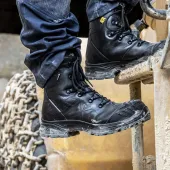HSE statistics highlight workplace dangers

Health and Safety Executive publishes latest annual statistics on workplace injury and ill health
FIGURES published last week show that while Britain continues to be one of the safest places to work in Europe, too many workers are still being injured or made ill by work.
Injury and ill-health statistics released by the Health and Safety Executive (HSE) show that an estimated 28.2 million working days were lost due to work related ill health or injury in 2013/14.
As a result, the cost to society from such injuries and new cases of ill health due to current working conditions is an estimated £14.2 billion (2012/13 figures based on 2012 prices), according to the latest annual statistics published by the HSE.
Judith Hackitt, chair of the HSE, says that behind every number is the reality of a real person being killed or suffering injuries or ill health while simply doing their job.
The statistics show that, in 2013/14, there were:
- 133 fatal injuries – a fall of 17 from 150 the previous year
- 77,593 other injuries were reported under RIDDOR, equating to 304.6 injuries per 100,000 employees
- An estimated two million people in 2013/14 were suffering from an illness they believed was caused or made worse by current or past work.
Judith Hackitt (pictured) said: ‘These latest figures help us remember what health and safety is really about. We should remind ourselves what these numbers actually mean – the number of times in the last year someone went out to work and either did not return home to their loved ones or came home with life-changing injuries.
‘The health numbers also demonstrate the scale of harm being done to people’s health while at work, too often leading to premature death.
‘Jobsworths using ‘elf n safety as a convenient excuse for all manner of things, and those claiming health and safety is a burden, need to reflect on this. Britain has one of the best health and safety systems in the world, but that is cold comfort to those who have suffered loss or suffering that is so easily avoided with sensible and proportionate risk management.
‘We all need to commit to focusing on what really matters – ensuring more people return home from work every day and enjoy long and healthy working lives.’
The industries in which workers are most likely to be injured by their jobs have not changed significantly – with construction (1,900 major/specified injuries), agriculture (292 major/specified injuries), manufacturing (3,159 major/specified injuries) and waste and recycling (486 major/specified injuries) among the higher-risk sectors.









